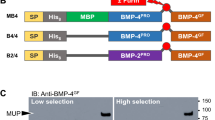Abstract
Cartilage-derived anti-tumor factor (CATF) inhibits the proliferation and DNA synthesis of bovine pulmonary artery endothelial (BPAE) cells in culture (Takigawa, M.et al. Cell. Biol. Inn. Rep., 9, 619–625, 1985). In the present study, we partially purified CATF by monitoring inhibition of DNA synthesis in BPAE cells and tested the effects of the purified materials on the growth of solid tumors and tumor-induced angiogenesis. Crude CATF (CATF20–300k), the fraction of 20 k to 300 k daltons, separated by ultrafiltration was further separated into three fractions by ultrafiltration. The fraction of 100 k to 300 k daltons (CATF100–300k) caused slightly more inhibition than CATF20–300k of DNA synthesis in BPAE cells. On the other hand, the fraction of 20 k to 50 k daltons had only a slight effect, and the fraction of 50 k to 100 k had even less effect on DNA synthesis in BPAE cells. CATF100–300k caused slightly more inhibition than CATF20–300k of the growth of solid tumors of B16 melanoma, while the fraction of 20 k to 100 k daltons did not inhibit the growth of tumors at all. CATF100–300k also inhibited B16 melanoma-induced angiogenesis in chick embryo chorioallantoic membranes (CAM), whereas the fraction of 20 k to 100 k daltons had little effect on the angiogenesis. CATF100–300k was further purified by DEAE-Sepharose CL-6B chromatography. The main peak with activity on DNA synthesis in BPAE cells was eluted with 0.3 to 0.35 M NaCl at pH 8.0. The activity of this peak on DNA synthesis in BPAE cells was about 70 fold that of CATF100–300k. The purified CATF also inhibited the growth of B16 melanoma and B16 melanoma-induced angiogenesis in CAM. On the other hand, the inactive fraction on DNA synthesis in BPAE cells obtained by DEAE-Sepharose chromatography was also inactive in inhibiting the growth of B16 melanoma and B16 melanoma-induced angiogenesis in CAM. These findings strongly suggest that CATF is an anionic macromolecule(s) and has anti-angiogenic activity, thereby inhibiting the growth of solid tumors.
Similar content being viewed by others
References
Algire, G.H. and Chalkley, H.W.: Vascular reactions of normal and malignant tissuein vivo. I. Vascular reactions of mice to wounds and to normal and neoplastic transplants. J. Natl. Cancer. Inst. 6, 73–85, 1945.
Folkman, J.: Tumor angiogenesis. Adv. Cancer Res. 19, 331–358, 1974.
Folkman, J.: Tumor angiogenesis: A possible control point in tumor growth. Ann. Int. Med. 82, 96–100, 1975.
Eisenstein, R., Schumacher, B., Meineke, C., Matijevitch, B. and Kuettner, K.E.: Growth regulators in connective tissues. Am. J. Pathol. 91, 1–9, 1978.
Irving, J.T. and Heeley, J.D.: The effect of enzyme treatment upon the resorption of scapular implants. Calcif. Tissue Res. 5, 64–69, 1970.
Langer, R., Brem, H., Falterman, K., Klein, M. and Folkman, J.: Isolation of a cartilage factor that inhibits tumor neovascularization. Science 193, 70–72, 1976.
Langer, R., Conn, H., Vacanti, J., Haudenschild, C. and Folkman, J.: Control of tumor growth in animals by infusion of an angiogenesis inhibitor. Proc. Natl. Acad. Sci. USA 77, 4331–4335, 1980.
Kuettner, K.E., Hiti, J., Eisenstein, R. and Harper, E.: Collagenase inhibition by cationic proteins. Biochem. Biophys. Res. Commun. 72, 40–46, 1976.
Kuettner, K.E., Soble, L., Croxen, R.L., Marczynska, B., Hiti, J. and Harper, E.: Tumor cell collagenase and its inhibition by a cartilage-derived protease inhibitor. Science 196, 653–654, 1977.
Suzuki, F., Takigawa, M., Hiraki, Y., Kato, Y., Shiio, T. and Yugari, Y.: Cartilage-derived antitumor factor (CATF): A high molecular weight fraction in cartilage extract inhibits solid tumor growth. J. Bone Mineral Metab. 2, 231–234, 1984.
Takigawa, M., Shirai, E., Enomoto, M., Hiraki, Y., Fukuya, M., Suzuki, F., Shiio, T. and Yugari, Y.: Cartilage-derived anti-tumor factor (CATF) inhibits the proliferation of endothelial cells in culture. Cell. Biol. Int. Rep. 9, 619–625, 1985.
Simpson-Herren, L., Sanford, A.H. and Holmquist, J. P.: Cell population kinetics of transplanted and metastatic Lewis lung carcinoma. Cell Tissue Kinet. 7, 349–361, 1974.
Klagsbrun, M., Knighton, D. and Folkman, J.: Tumor angiogenesis activity in cells grown in tissue culture. Cancer Res. 36, 110–114, 1976.
Tsukamoto, K. and Sugino, Y.: Tumor angiogenesis activity in clonal cells transformed by bovine adenovirus type 3. Cancer Res. 39, 1305–1309, 1979.
Bradford, M.M.: A rapid and sensitive method for the quantitation of microgram quantities of protein utilizing the principle of protein-dye binding. Anal. Biochem. 72, 248–254, 1976.
Langer, R. and Murray, J.: Angiogenesis inhibitors and their delivery systems. Appl. Biochem. Biotech. 8, 9–24, 1983.
Eisenstein, R., Sorgente, N., Soble, L.W., Miller, A. and Kuettner, K.E.: The resistance of certain tissues to invasion. Am. J. Pathol. 73, 765–774, 1973.
Rifkin, D.B. and Crowe, R.M.: Isolation of a proteinase inhibitor from tissues resistant to tumor invasion. Hoppe-Seyler's Z. Physiol. Chem. 358, 1525–1531, 1977.
Sorgente, N. and Dorey, C.K.: Inhibition of endothelial cell growth by a factor isolated from cartilage. Exp. Cell Res. 128, 63–71, 1980.
Jacobson, B., Basu, P.K. and Hasany, S.M.: Vascular endothelial cell growth inhibitor of normal and pathologic human vitreous. Arch. Ophthalmol. 102, 1543–1545, 1984.
Brem, S., Brem, H., Folkman, J., Finkelstein, D. and Patz, A.: Prolonged tumor dormancy by prevention of neovascularization in the vitreous. Cancer Res. 36, 2807–2812, 1976.
Brem, S., Preis, I., Langer, R., Brem, H., Folkman, J. and Patz, A.: Inhibition of neovascularization by an extract derived from vitreous. Am. J. Ophthalmol. 84, 323–328, 1977.
Felton, S.M., Brown, G.C., Felberg, N.T. and Federman, J.L.: Vitreous inhibition of tumor neovascularization. Arch. Ophthalmol. 97, 1710–1713, 1979.
Lee, A. and Langer, R.: Shark cartilage contains inhibitors of tumor angiogenesis. Science 221, 1185–1187, 1983.
Taylor, S. and Folkman, J.: Protamine is an inhibitor of angiogenesis. Nature 297, 307–312, 1982.
Author information
Authors and Affiliations
About this article
Cite this article
Takigawa, M., Shirai, E., Enomoto, M. et al. Cartilage-derived anti-tumor factor (CATF). J Bone Miner Metab 6, 29–38 (1988). https://doi.org/10.1007/BF02375643
Issue Date:
DOI: https://doi.org/10.1007/BF02375643




